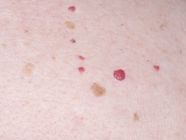Chickenpox is a very common infection in children (and less commonly in adults) caused by a virus called varicella.
That’s why it’s important to recognize the early signs that may indicate your child has the virus—and to know the best
ways to ease their discomfort during the infection. (1)
What Does Chickenpox Look Like at First?
The itchy skin rash is the most recognized sign of chickenpox: (1)(2)
- Stage one: The rash starts as small spots that vary in color depending on skin tone—brown, purple, or gray on darker skin, and red on lighter skin.
- Spread: These spots typically appear in small numbers in one area, such as the neck, chest, back, abdomen, or face, then spread to other areas within hours.
- Worsening: After a few days, the rash covers most of the body and becomes intensely itchy.
- Development: The spots turn into fluid-filled blisters that burst and dry out into crusty scabs within about a week.
- Crops of rash: New blisters continue to appear in waves for 3 to 5 days. You might notice that some areas have newly formed red spots, others have blisters, and some are already scabbing over.
Early Symptoms
Chickenpox symptoms usually appear 10 to 21 days after exposure to the virus. Some children may feel unwell before the rash begins. These early symptoms include: (3)
- Muscle aches
- Headache
- Sore throat
- Nausea
- Loss of appetite
The rash typically begins 1 to 2 days after these early symptoms.
Contagious Period
Chickenpox is highly contagious and spreads easily from person to person. It becomes contagious two days before the rash appears and remains contagious until all the blisters have dried out—a process that can take 5 to 10 days. (4)
It spreads quickly in crowded places like nurseries, schools, or public play areas. The virus can be transmitted through: (4)
- Sneezing or coughing droplets from an infected person
- Direct contact with the fluid from chickenpox blisters
Relieving Symptoms
If your child is generally healthy, chickenpox usually clears up on its own without specific treatment. However, you can ease the symptoms and itching at home with these tips: (5)
- Keep your child well-hydrated to prevent dehydration.
- Trim their nails short to avoid scratching and scarring.
- Encourage your child not to scratch the blisters. Use mittens or socks on their hands during sleep to reduce itching.
To relieve itching:
- Use cool compresses or wet cloths on itchy areas.
- Try calamine lotion, but be aware it can dry out the skin.
- An oatmeal bath can help soothe the skin.
- Moisturizing creams or ointments may also be helpful.
- For severe itching, antihistamines (allergy medications) may be used under a doctor’s guidance, depending on the child’s age.
When Should You See a Doctor?
Consult a doctor if: (3)
- The rash spreads to the eyes.
- The rash becomes very red or painful.
- The child’s fever exceeds 38.9°C (102°F).
- Your child shows other concerning symptoms like dizziness, confusion, or trouble breathing.
- Your child lives with someone who:
- Is pregnant and never had chickenpox
- Has a weakened immune system
- Has not had chickenpox or the vaccine
Before Visiting the Clinic:
Call ahead to avoid exposing others in the waiting area, and inform the clinic that you suspect chickenpox.
At Al-Ahli Hospital, our pediatricians provide comprehensive care and support to help your child recover quickly and comfortably.






